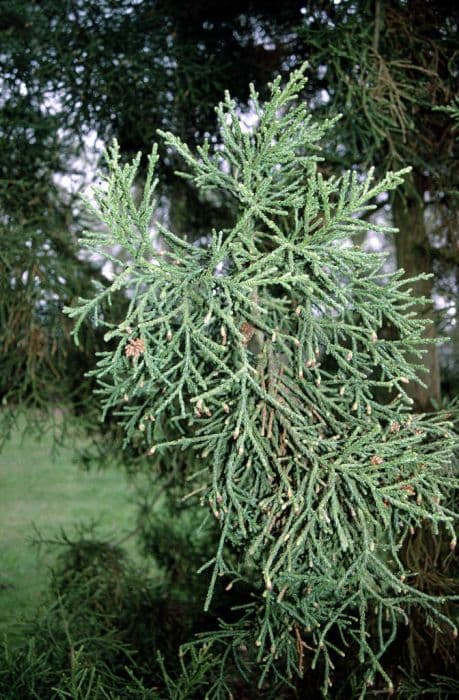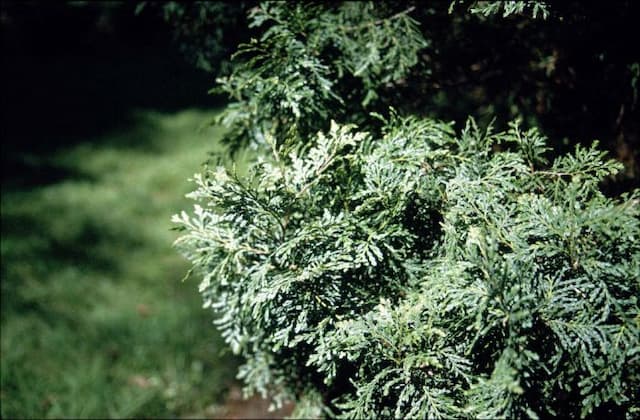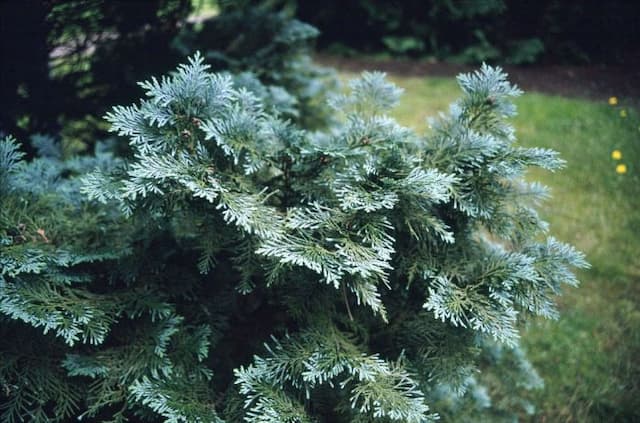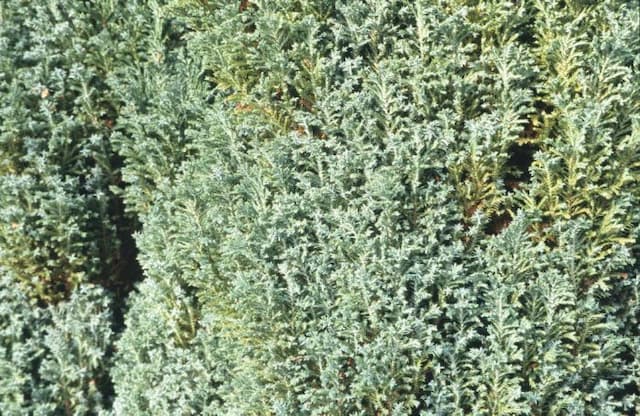Dawn Redwood Metasequoia glyptostroboides 'White Spot' (v)

ABOUT
The Dawn Redwood 'White Spot' variant is a visually striking tree with distinctive foliage. This particular tree is characterized by its feathery, soft leaves that exhibit a unique variegation pattern. Typically, the leaves have a bright green color. However, in the case of the 'White Spot' variant, the green is interrupted by creamy white spots and streaks, which give it a speckled appearance. This variegation can create a shimmering effect when the tree moves in the breeze. The foliage grows in opposite pairs and is generally linear. The leaves are attached to the branches by short petioles, which allow them to flutter gracefully. The overall structure of the tree consists of a pyramidal shape with horizontal to slightly drooping branches that form a tiered appearance. During the spring and summer, the variegated leaves create a lush, textured canopy that can add lightness to the landscape. In the fall, the Dawn Redwood 'White Spot' puts on another show as the leaves turn to a golden brown before shedding, as this tree is deciduous, meaning it loses its leaves annually. The bark of the tree is also worth noting; it has a reddish-brown hue and develops deep grooves and flares as it matures, giving it a very textured and rugged look. The appearance of the Dawn Redwood 'White Spot' is particularly appreciated for its year-round interest—the striking variegated foliage in the growing season, the warm tones of the fall foliage, and the stately silhouette and textured bark that become more prominent in the winter after the leaves have fallen. Each of these traits contributes to making this tree a compelling addition to a garden or landscape looking to make a statement with plant features beyond sheer size.
About this plant
 Names
NamesFamily
Cupressaceae
Synonyms
Dawn Redwood, Water Fir, Shui-shan
Common names
Metasequoia glyptostroboides
 Toxicity
ToxicityTo humans
The common name for Metasequoia glyptostroboides 'White Spot' is Dawn Redwood. Dawn Redwood is not known to be toxic to humans. Therefore, there are no symptoms of poisoning or toxic consequences associated with ingesting any part of this plant.
To pets
The common name for Metasequoia glyptostroboides 'White Spot' is Dawn Redwood. Dawn Redwood is not known to be toxic to pets. Thus, there are no symptoms of poisoning or toxic consequences associated with pets ingesting any part of this plant.
 Characteristics
CharacteristicsLife cycle
Perennials
Foliage type
Deciduous
Color of leaves
Green
Height
70 feet (21 meters)
Spread
25 feet (7.6 meters)
Plant type
Tree
Hardiness zones
5
Native area
China
Benefits
 General Benefits
General Benefits- Ornamental Appeal: 'White Spot' has a unique variegation on its foliage that provides visual interest in landscape designs.
- Seasonal Interest: The dawn redwood is deciduous, offering bright green foliage in spring and summer that turns to copper-orange tones in fall.
- Shade Provision: As a large tree, it provides significant shade, which can create a cool area in gardens and reduce cooling costs for nearby buildings.
- Wildlife Habitat: This tree can offer habitat and food sources for various bird species and other wildlife.
- Historical Significance: The dawn redwood is known as a "living fossil" as it was believed to be extinct until its rediscovery, making it of interest to those intrigued by plant history.
- Adaptability: It is adaptable to a range of soil types, provided the soil is moist and well-draining.
- Fast Growth: The dawn redwood is a fast-growing tree, which allows for quicker establishment and attainment of its ornamental benefits.
- Low Maintenance: Once established, it does not require extensive care beyond routine maintenance.
 Medical Properties
Medical PropertiesThis plant is not used for medical purposes.
 Air-purifying Qualities
Air-purifying QualitiesThis plant is not specifically known for air purifying qualities.
 Other Uses
Other Uses- Dawn Redwood 'White Spot' can be used in woodworking and crafts due to its attractive wood grain and texture. Its lumber is occasionally incorporated into small woodworking projects like crafting custom pen bodies or ornamental boxes.
- This tree's bark, being quite fibrous, can be processed to create a rough fabric or paper-like material, which could serve for artistic or educational purposes, teaching about traditional paper-making methods.
- The small, leafy branches of the Dawn Redwood 'White Spot' can be used in floral arrangements or wreaths, especially given their unique variegation, to add a rustic and unusual eye-catching element.
- Because of its distinctive appearance, this tree can be utilized as a focal point in photography, offering a contrasting backdrop for portrait or landscape photography.
- The cones of the Dawn Redwood 'White Spot' can be used in arts and crafts, like making natural jewelry or as decorative elements in home decor or seasonal displays.
- The tree's fallen needles, which are deciduous, can be gathered and used to create a natural mulch or compost, assisting in the suppression of weeds or as a means of recycling organic material back into the garden.
- Large specimens can serve as natural sound barriers when planted in groups, helping reduce noise pollution in urban or suburban settings.
- The wood can also be used in the production of musical instruments like flutes or woodwinds, allowing for unique sounds due to the wood's qualities.
- Extracts from the Dawn Redwood 'White Spot' leaves and twigs, though not medicinal, can be used in creating natural dyes for textiles, offering a range of colors from the tannins present in the plant material.
- Its fast-growing nature makes Dawn Redwood 'White Spot' a candidate for use in educational programs that teach about the lifecycle of trees and the importance of conservation and reforestation efforts.
Interesting Facts
 Feng Shui
Feng ShuiThe Dawn Redwood is not used in Feng Shui practice.
 Zodiac Sign Compitability
Zodiac Sign CompitabilityThe Dawn Redwood is not used in astrology practice.
 Plant Symbolism
Plant Symbolism- Renewal: The Metasequoia glyptostroboides, commonly known as the Dawn Redwood, is a deciduous conifer that loses its leaves in fall and regrows them in spring. This cyclical process signifies rebirth and new beginnings.
- Resilience: Having been once considered extinct and then rediscovered as a living species, the Dawn Redwood symbolizes resilience and the ability to endure difficult conditions over time.
- Longevity: The Dawn Redwood, being a relative of trees that date back to ancient times, symbolizes longevity and the connection to the past.
- Adaptability: As a tree that has survived major geological changes and was able to adapt to different climates, the Dawn Redwood represents adaptability and flexibility in the face of change.
 Water
WaterDawn Redwoods, which is the most common name for Metasequoia glyptostroboides 'White Spot,' should be watered deeply and infrequently to encourage a strong root system. During the growing season, watering once a week with about 1.5 to 2 gallons of water per watering session is ideal, depending on the tree's size and the soil moisture levels. In hot, dry periods, increase watering to twice a week. During the winter months when the tree is dormant, reduce watering to when the soil appears dry. It's essential to avoid waterlogging, so ensure the planting site has good drainage.
 Light
LightDawn Redwoods thrive best in full sunlight to partial shade. They should be planted in a spot where they receive at least six hours of direct sunlight daily. Avoid deep shade locations to ensure healthy growth and development.
 Temperature
TemperatureThe Dawn Redwood is a hardy tree that can tolerate a range of temperatures. It can survive minimum temperatures down to about -20°F but grows best in areas where the temperature ranges from 60°F to 85°F. The ideal temperature conditions for this tree are moderate and consistent; extreme heat or cold can stress the plant.
 Pruning
PruningPrune Dawn Redwoods to maintain shape and remove any dead or broken branches. The best time for pruning is during the dormant season, late winter or early spring before new growth starts. Thinning out the canopy can allow for better air circulation and light penetration. Prune lightly as the tree has a naturally attractive shape, and over-pruning can damage the tree's structure.
 Cleaning
CleaningAs needed
 Soil
SoilDawn Redwood 'White Spot' thrives in a well-draining soil mixture composed of equal parts loam, peat, and sand or perlite, promoting healthy root growth. Aim for a soil pH between 5.0 and 7.0, which is slightly acidic to neutral, for optimal growth.
 Repotting
RepottingDawn Redwood 'White Spot' should be repotted every two to three years to replenish soil nutrients and prevent root bounding. Younger plants may need more frequent repotting, while mature trees can be repotted less often.
 Humidity & Misting
Humidity & MistingDawn Redwood 'White Spot' prefers moderate to high humidity levels. Aim to maintain humidity around 40-60% for optimal growth, as this mimics its natural habitat conditions effectively.
 Suitable locations
Suitable locationsIndoor
Not ideal for indoor growth due to size.
Outdoor
Plant in full sun, moist soil, space well.
Hardiness zone
4-8 USDA
 Life cycle
Life cycleDawn Redwood 'White Spot' begins its life as a seed, which upon germination grows into a small seedling, featuring the characteristic deciduous needle-like leaves with a variegated pattern. As the seedling matures into a juvenile tree, it develops a conical form with a straight trunk and horizontal to slightly upswept branches. The tree enters its reproductive phase within a few years, producing small, rounded cones which are the plant's reproductive organs. Mature Dawn Redwoods can reach significant heights of over 100 feet, and continue to produce cones annually, which disperse seeds that give rise to new seedlings. During its long lifespan, which can be several hundred years, the Dawn Redwood 'White Spot' undergoes seasonal changes, losing its leaves in the fall and regrowing them in the spring. The tree gradually ages and eventually, upon reaching the end of its life cycle, succumbs to environmental stresses or natural senescence, decomposing to contribute to the nutrient cycle.
 Propogation
PropogationPropogation time
Spring-Early Summer
The most popular method for propagating the Dawn Redwood 'White Spot' variant involves taking softwood cuttings during late spring or early summer when the wood is new and green but sufficiently mature to sustain new growth. A cutting typically includes a few inches of the stem with at least one node and a couple of leaves, which would be around 4 to 6 inches (10 to 15 centimeters) long. This cutting should be taken with a sharp, clean pair of shears to avoid damaging the parent plant or the cutting itself. It's important to keep the cutting moist until it is planted. The stem is then dipped into a rooting hormone powder to encourage root development and planted in a well-draining soil mix. The soil should be kept consistently moist but not waterlogged, and the cuttings should be placed in an area with bright, indirect light. With appropriate care, roots will usually develop within a few weeks, after which the new Dawn Redwood can be gradually acclimatized to outdoor conditions before permanent planting.









